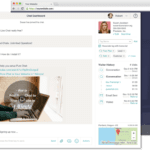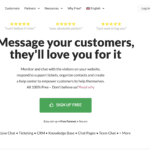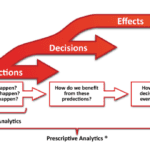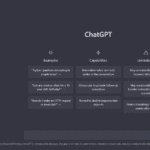What is a canned response, and how does it work?
A canned response is a pre-written message that can be inserted into a live chat or email conversation. They are also known as templates or stock replies are pre-written answers to commonly asked customer service questions. By creating canned response examples, businesses can provide quick and consistent customer support without having to type the same answer repeatedly.
Some common scenarios where canned responses can be helpful include welcoming new users, offering help with technical issues, and providing answers to frequently asked questions. They can also be a starting point for crafting more personalized customer service replies.
Canned responses can save time when responding to common questions or requests. They can also improve customer satisfaction by providing accurate and consistent information. To use a canned response, copy and paste the desired message into the live chat or email window. You can create canned responses for various customer service scenarios and customize them to fit the needs of any business.
Benefits of using canned responses
Live chat has become increasingly popular in recent years to provide customer support. In many cases, it is the preferred method of communication for customers who want immediate assistance. Live chat also has the advantage of being less expensive than a traditional phone call.
One of the critical benefits of canned responses is that they can help resolve issues more quickly. With a library of pre-written responses, agents can quickly find the information they need and provide a resolution to the customer. This can improve customer satisfaction and reduce the overall time it takes to resolve an issue.
Another benefit of canned responses is that they can be used to deflect common questions. In many cases, customers will have similar questions or concerns. With an answer ready, agents can quickly address these issues without starting from scratch each time. This can save a significant amount of time, especially when dealing with large numbers of customers.
Overall, canned responses can be a valuable tool for live chat agents. By helping to resolve issues more quickly and deflect common questions, they can improve the overall efficiency of the live chat process and help to improve customer satisfaction levels.
How to Get Started
If you’d like to create canned responses for your own business, here are some tips to get started:
- Brainstorm the most common types of customer service questions you receive. For example, some of these might be inquiries about order status, product availability, and return policies if you’re in the eCommerce business.
- Once you have a list of frequently asked questions, start writing a few drafts for each one. Again, aim to cover as many angles as possible while keeping your responses succinct.
- Once you have a few drafts for each question, review them with your team and make any necessary edits or changes. This is also the perfect time to add personalization elements such as customer name, order number, or product details.
- Store all of your canned responses in one centralized location. This could be a shared document, an intranet page, or a customer service software platform.
- Train your team on the proper use of canned responses and remind them to add personalization elements where applicable continuously.
List of Most Common Canned Responses
In customer support, it is often necessary to provide canned responses to common questions. This can save time and ensure that all customers receive the same level of service. However, it is essential to use templates judiciously, as they can often be impersonal or unhelpful. If you are considering using pre-made responses in your customer support chat or email system, here are a few templates that you can use today:
- Hi. Thank you for reaching out to us! How can I help you?
- Is there anything else I can do to assist you today?
- Can you tell me a bit more about your issue or concern?
- What can I do to help resolve this for you?
- Is there anything else I can do for you?
- Can I provide any additional information that might be useful?
- I understand how frustrating this must be. Let me see what I can do to help.
- Please provide me with a few more details. It would help me assist you better.
- Let me look into this further, and I’ll get back to you shortly with an update.
- Is there anything else I can help you with today?
- Please let me know if there is anything else I can do for you.
- I apologize for any inconvenience caused. Let me see how I can help.
- Is there anything else I can do to ensure you’re taken care of?
- How may I be of assistance today?
- Is there anything else I need to know?
- What can I do to help make this better for you?
- Could you share more about the issue so I can investigate it further?
- Please let me know if there is anything else I can do to assist you
- What questions do you have about the product/service that I can answer for you?
- Is there anything else I’d like to discuss today?
- What else can I do for you?
- How else can I help you today?
- Is there anything else I can assist you with?
- Can I provide any more information or assistance on this issue?
- How may I further assist you today?
- Is there anything else I can do for you before we close this conversation?
- Is there anything else I can help you with today?
- Is there anything else I can do to ensure you are satisfied with your experience?
- Thank you for contacting us! We appreciate your feedback and will do our best to answer your questions as quickly as possible.
- Our team is available to help with inquiries or concerns 24 hours a day, seven days a week. Please don’t hesitate to reach out if you need assistance.
- We apologize for any inconvenience this may have caused. We understand your frustration and will work to ensure it doesn’t happen again.
- Our goal is to provide the best customer service possible, so please let us know if there’s anything else we can do for you.
- That’s a great question, but to be honest, I may not be the right person to answer it. So I am transferring to the expert for an accurate answer.
- Our business hours are from 8:00 am to 5:00 pm. Please leave a message, and we will get back to you soon. For anything urgent, you can email us at (email@).
- We value your business and appreciate your patience as we work to resolve any issue.
- We’re sorry you’re having trouble with our product/service. Please let us know how we can help.
- We take customer satisfaction very seriously and will investigate the issue promptly to ensure a satisfactory resolution.
- Thank you for bringing this to our attention! We’ll work quickly to resolve the issue and get you back to enjoying our product/service.
- We apologize for any confusion or frustration this may have caused. Please let us know what we can do to help.
- Your feedback is very important to us, and we appreciate your contacting us. We’ll look into this immediately and do our best to ensure it doesn’t happen again.
- We understand that you’re having difficulty, and we’ll do our best to help. Please let us know what we can do for you.
- Our team is here to assist in any way possible. If there is anything else we can do, please let us know!
- We apologize for the inconvenience this has caused and will work quickly to resolve it as soon as possible.
- Your continued patience is much appreciated while we look into this issue further and strive to provide the highest quality of customer service available.
- Thank you for bringing your concerns to our attention—we will ensure they are addressed promptly and professionally.
Training agents to use canned responses
In the customer service industry, it is often necessary to provide agents with guidance on responding to common inquiries. One way to do this is through the use of canned responses. Canned responses are pre-written responses to common questions that can be easily inserted into a conversation. While they may seem impersonal, canned responses can be an effective way to ensure that agents are providing accurate and consistent information. They can also be used as a starting point for more personalized responses. When used correctly, pre-made responses can help improve customer service quality.
By using canned responses sparingly and tailoring them to each customer’s individual needs, you can provide efficient customer support without sacrificing the personal touch.
Virtual assistants
The role of virtual assistants (chatbots) in customer service has been increasing rapidly over the last few years due to their ability to provide quick and accurate responses. Virtual assistants can be an excellent tool for businesses that streamline their customer service processes, as they can handle multiple requests simultaneously with minimal cost. They can also provide customers with automated pre-made responses, which can help save time and resources. This is especially useful for companies that receive a high volume of similar customer requests, as canned responses allow them to quickly provide accurate answers without having to spend time crafting individualized replies. By utilizing virtual assistants and pre-made responses, businesses can provide customers with a more efficient customer service experience. Chatbot.com, Intercom, Zendesk among others provide an AI powered virtual assistant for live chat support.
In addition to providing quick answers to customer inquiries, virtual assistants also can collect data from customers that can be used to customize their experience. This is done by asking them questions or using natural language processing to gain insights into their needs and preferences. This data can tailor the customer experience, providing personalized answers and recommendations most likely to meet their needs. By using virtual assistants in this way, businesses can ensure that they are always providing customers with the highest quality service possible.
Overall, virtual assistants and canned responses in customer service are becoming increasingly important. By utilizing these tools, businesses can provide customers with a more efficient and personalized customer service experience, ultimately leading to increased satisfaction and loyalty. As the demand for virtual assistants increases, businesses should consider leveraging this technology to improve their customer service processes.
Tips for using canned responses effectively in your business communications
In today’s fast-paced world, it’s essential to communicate quickly and efficiently. One way to do this is to use canned responses in your business communications. Pre-written messages can be inserted into an email or chat window with just a few clicks. When used sparingly, they can be a valuable tool for streamlining your communication. However, there are a few things to remember when using canned responses:
- Make sure that the message is relevant to the situation.
- Personalize the message as much as possible so it doesn’t sound like a template.
- Use canned responses sparingly, or your recipient may think you’re being impersonal or lazy.
Used judiciously, canned responses can help you save time and communicate more effectively.
Consider adding some automation to take it up a notch. For example, automated tools such as chatbots and virtual assistants can provide instant answers to customer inquiries and significantly reduce the time it takes to provide support.
Regardless of your business or industry, canned responses are a great way to ensure quick and consistent customer service without sacrificing quality. So get started today and watch your happy customers multiply!










